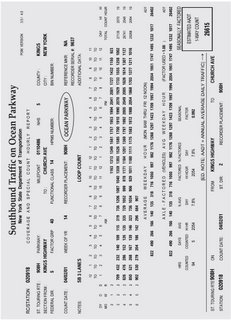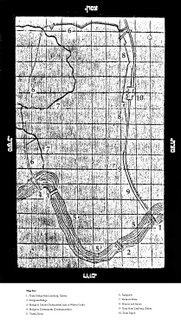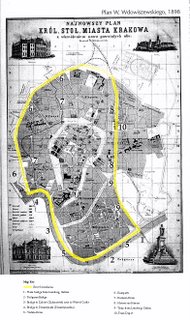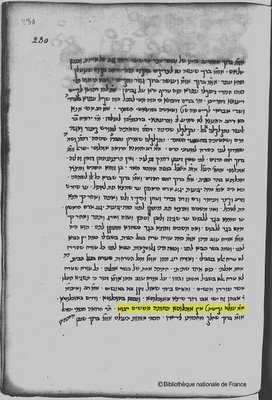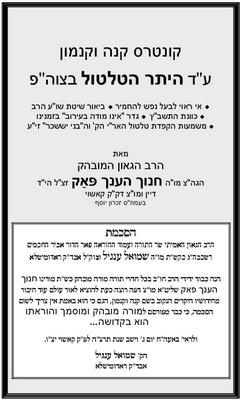The fact is that the Achiezer never mentions a word in his teshuvah that the heter is only bedieved since it was based on the overwhelming majority of Achronim. These issues are accepted as halachah pesuka and not as great chiddushim (see The Overwhelming Majority of Achronim Maintain Lo Asu Rabbim U’Mevatlei Mechitzta and Pirtzos, Biblical or Rabbinical proscription?). If one were to read this teshuvah, they would clearly see that the Achiezer accepts as a given that pirtzos esser is a d’rabbanan and that we pasken lo asu rabbim u’mevatlei mechitzta. Additionally, since the Achiezer maintained that the situation in Paris was a matter of a d’Oraysa, he would definitely have stated that the heter for the eruv is only a bedieved. Therefore, these claims are fictitious.
It’s explicable that the anti-eruv group would wish this Achiezer out of existence; however, they found in it a redeeming value, the only support of their opinion of the criterion of shishsim ribo. The Achiezer really is the only posek who it would seem at first glance maintains that shishim ribo is conditional of the city. (This is different then Rav Moshe’s shitah that the requirement of shishim ribo is over an area of twelve mil by twelve mil containing a population of 3,000,000. More so, Rav Moshe maintained that eruvin were established in cities that contained a population of shishim ribo; see The Requirement of Shishim Ribo: Is It Conditional on a City or a Street). Therefore, I set out to illuminate what is really the Achiezer’s opinion regarding shishim ribo.
These are the words of the Achiezer (4:8), "והנה בודאי נראה שפריז היא רה"ר גמורה מה"ת שיש בה ששים רבוא בוקעים אע"פ שאין בה בכל רחוב ס' רבוא" “Paris is definitely a reshus ha’rabbim me’d’Oraysa since it contains shishim ribo traversing it even though not every street includes shishim ribo.” The Achiezer adds that the Bais Ephraim also declared that Paris was a reshus harabbim [of shishim ribo]. The Achiezer therefore wanted to establish that the riverbanks, which surrounded Paris on three sides, were sufficient as mechitzos thereby removing Paris from the category of a reshus harabbim.
Let’s explore this Bais Ephraim that the Achiezer mentions. The Bais Ephraim (O.C. siman 26 p. 45) states that the reason why some Rishonim only mention as the criteria of a reshus harabbim that a street would need to be sixteen amos wide and mefulash me’shar le’shar (and not shishim ribo) is because there were cities such as Paris, London, Vienna and Frankfort-on-Main that did contain shishim ribo. Therefore, the Bais Ephraim postulates these Rishonim only mentioned the criteria that pertained to them and allowed them to erect eruvin in these cities. [It’s important to note that the Bais Ephraim clearly maintains that shishim ribo is conditional of the street; see for instance his quoting of the question posed to the Chacham Tzvi, (siman 37), stating that the sratyas and platyas of England possibly had shishim ribo traversing them which obviously is referring to single thoroughfares. This is one of the proofs that the Bais Ephraim is of the opinion that shishim ribo is conditional of a street as opposed to the city (for an explanation of the Bais Ephraim’s shita see The Overwhelming Majority of Achronim Maintain That the Shishim Ribo Has to Traverse the Street Itself).]
This leaves us with a difficulty, why did the Achiezer only cite the Bais Ephraim regarding Paris being a reshus harabbim of shishim ribo and not utilize the Bais Ephraim’s heter enabling the establishment of an eruv in Paris and in other big cities by evaluating each street independently to see if it is less than sixteen amos wide or if it isn’t mefulash?
By clarifying the Achiezer’s position regarding shishim ribo, we will shed light on the entire teshuvah:
These words "אע"פ שאין בה בכל רחוב ס' רבוא" are the key to understanding the Achiezer. These words denote that the Achiezer necessitates at least one street that would need to meet the requirement of shishim ribo traversing it and only then would the entire city be classified as a reshus harabbim (for a similar ruling see Aishel Avraham, O.C. 345). Therefore, it’s incorrect to assert that the Achiezer’s position regarding shishim ribo is conditional of a city and not a street since at least one street would be required to have shishim ribo traversing it (see also Kovetz Ohr Yisroel, vol. 18, p. 18-19).
With this we can understand the entire teshuvah of the Achiezer. Since an eruv, utilizing the waterfront was to encompass the whole city of Paris, it would by default encompass a street that had shishim ribo traversing it. In order to utilize the Bais Ephraim’s suggestion, the Achiezer would need to evaluate that street: whether it was less than sixteen amos wide and not mefulash. If the street nevertheless met all these criteria of reshus harabbim (it was sixteen amos wide, mefulash and had shishim ribo traversing it), the Achiezer would have to require that they exclude that problematic street from the boundaries of the eruv. However, building the tzuras hapesachim to encompass Paris that would have allowed them to exclude a street that meets all the criteria of a reshus harabbim was not an option (the authorities didn’t even allow them to close the pirtzos with tzuras hapesachim and for this reason alone the eruv was never established; see Divrei Menachem, O.C. vol. 2, p. 39). The better alternative was to establish that Paris’s waterfront was halachically sufficient as mechitzos because in any case they would remove the city from the status of a reshus harabbim. Accordingly, the Achiezer maintained that one street in Paris had the status of a reshus harabbim of shishim ribo (which he understood from this Bais Ephraim), and until it was established that Paris had sufficient mechitzos (which he did confirm in this teshuvah), it would not be permissible to establish an eruv for the entire city of Paris because then it would have to include that problematic street in the given boundaries. Hence, the Achiezer called the whole of Paris a reshus harabbim.

